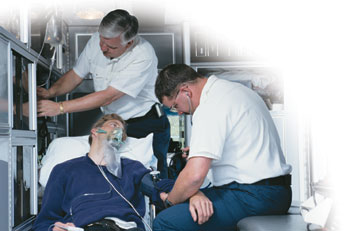|

Clinic Aims to Help Toronto
Construction Workers
December 2004 IBEW
Journal
In Ontario, workers have a long
and dedicated history of fighting hard on health and safety
issues. But last year was a tough one in Ontario. Thirty
workers were killed in construction-related accidents,
an increase of over 50 percent from the previous year. Yet
even these tragic statistics pale in comparison to the
number of suspected deaths from occupational disease each
year that go undiagnosed, unreported or uncompensated.
That is why the Central Ontario Building
Trades conducted an intake clinic to help increase awareness
about asbestos and other toxins responsible for the development
of occupational diseases in the construction industry.
The June clinic also informed the participants on the rights
of workers and their families to just compensation as well
as the need for increased focus and preventive action.
"We have members still falling to
their deaths, but many more are slowly and silently dying
at home of diseases caused by workplace exposures," said
Jay Peterson, business manager for the Central Ontario
Building Trades Council. "A death is a death is a
death. As our members die unnoticed, so do opportunities
to put measures in place to prevent more tragedies."
Every building trade affiliate was supportive
and participated in the intake clinic, but none more so
than IBEW Local 353. The intake clinic gave workers the
opportunity to document their work history, check for illness
and provide each worker with a "health benchmark" for
future medical review and to assist with potential compensation
claims. Nearly 40 members of Local 353 participated.
Ontarios Workplace Safety Insurance
Board reports that from 1991 to 2000 more than half of
the fatal occupational disease claims for the construction
sector were for mesothelioma, a cancer that is almost exclusively
caused by asbestos exposure. Peterson suggested anecdotal
evidence shows that 80 percent of the workers reporting
to the clinic were documented as having been exposed to
asbestos.
More than screening members for illness,
the clinic will use the data to highlight trades-specific
factors and patterns of illness. It revealed electricians
had a large number of left wrist injuries. Many also suffer
from hearing loss. As a result of the preliminary medical
findings for electricians, the Occupational Health Clinics
for Ontario Workers and Local 353 are in the process of
coordinating a separate intake clinic for Local 353 members.
The province is investigating why electricians have a large
number of reproductive and lower tract diseases as well
as a disproportionate number of upper extremity and muskuloskeletal
injuries. The next intake clinic is being organized for
the new year.
John Smith, business representative for
the Building Trades and a member of IBEW Local 353, cites
the fact that every trade has a higher incidence of cancer
than the general population. "Our members work everywhere
from chemical plants and refineries to nuclear facilities
and are continually exposed to all types of hazards. In
many cases we are not even aware of the danger. It is vitally
important for us to continue to educate all our workers
and employers about safe practices and safe alternative
materials."
Local 353 Business Manager Joe Fashion
said an effective hazard control program is difficult in
a sector characterized by ever-changing work sites, short-term
assignments and tight, money-driven work schedules. Nonetheless,
he says, "Each intake clinic not only helps workers
and their unions identify deadly exposures, but strengthens
a growing grass roots movement resolved to prevent exposures
in the first place."
A direct result of union clinics in Ontario
has been reduced exposure levels for a host of substances.
The newly elected provincial government has also, because
of worker concerns and rising compensation cost, recently
passed legislation to hire 200 more health and safety officers
across the province.
Groups involved with planning the clinic
included Occupational Health Clinics for Ontario Workers
(OHCOW), Building Trades Worker Services, Ontario Federation
of Labour, Workplace Safety and Insurance Board, Workers
Health and Safety Centre and Construction Safety Association
of Ontario.

|
